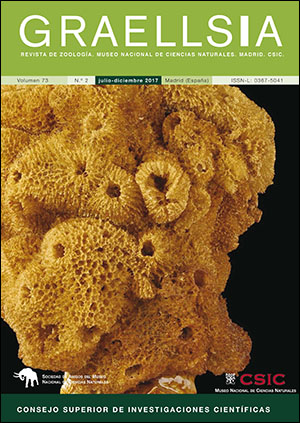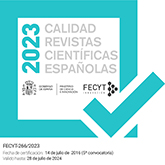Boyeria irene (Fonscolombe, 1838) y Cordulegaster boltonii (Donovan, 1807) (Odonata): dos estrategias en cuanto a sustratos de emergencia de larvas en un mismo hábitat
DOI:
https://doi.org/10.3989/graellsia.2017.v73.180Palabras clave:
Ríos, Odonata, Aeshnidae, Cordulegastridae, exuvias, EspañaResumen
Se presentan datos sobre emergencia de Cordulegaster boltonii y Boyeria irene en un río de montaña del centro de España (altitud 1200 m s.n.m.) donde coexisten ambas especies, basados en la recogida semanal de exuvias. Boyeria irene comenzó a emerger 28 días más tarde que C. boltonii. Los sustratos usados por las larvas de ambas especies para emerger se solaparon ampliamente, aunque C. boltonii utilizó significativamente más árboles. Con respecto a otras zonas geográficas, las dos especies han modificado su estrategia, retrasando el inicio del periodo de emergencia. Se discute la importancia de las condiciones ambientales (sobre todo temperatura) en este hecho.
Descargas
Citas
Aliberti Lubertazzi, M. A. & Ginsberg, H. S., 2009. Persistence of dragonfly exuviae on vegetation and rock substrates. Northeastern Naturalist, 16: 141–147. https://doi.org/10.1656/045.016.0112
Bravo, F., Álvarez, J. G. & Del Río, M., Barrio, M., Bonet, J. A., Bravo-Oviedo, A., Calama, R., Castedo-Dorado, F., Crecente-Campo, F., Condes, S., Diéguez-Aranda, U., González-Martínez, S. C., Lizarralde, I., Nanos, N., Madrigal, A., Martínez-Millán, F. J., Montero, G., Ordó-ez, C., Palahi, M., Pique, M., Rodríguez, F., Rodríguez-Soalleiro, R., Rojo, A., Ruiz-Peinado, R., Sánchez-González, M., Trasobares, A. & Vázquez- Piqué, J. 2011. Growth and yield models in Spain: historical overview, contemporary examples and perspectives. Instituto Universitario de Investigación en Gestión Forestal Sostenible (Universidad de Valladolid-INIA) & Unidad de Gestión Forestal Sostenible (Universidad de Santiago de Compostela). Forest Systems, 20(2): 315–328. https://doi.org/10.5424/fs/2011202-11512
Bried, J. T., d'Amico, F. & Samways, M. J., 2012. A critique of the dragonfly delusion hypothesis: why sampling exuviae does not avoid bias. Insect Conservation and Diversity, 5: 398–402. https://doi.org/10.1111/j.1752-4598.2011.00171.x
Casanueva, P., Campos, F., Velasco, T., Sanz, G. & Nunes, L. F., 2015. Selección de sustrato de emergencia por Cordulegaster boltonii (Donovan, 1807) (Odonata: Cordulegastridae) en un río del centro de la Península Ibérica. Boletín de la Sociedad Entomológica Aragonesa, 56: 349–350.
Confederación Hidrográfica del Duero, CHD, 2016. Anuario de aforos. Disponible en http://ceh-flumen64. cedex.es/anuarioaforos. Último acceso: 15-09-2016.
Corbet, P. S., 1954. Seasonal regulation in British dragonflies. Nature, 174: 655. https://doi.org/10.1038/174655a0
Corbet, P. S., 1957. The life-history of the Emperor Dragonfly Anax imperator Leach (Odonata: Aeshnidae). Journal of Animal Ecology, 26: 1–69. https://doi.org/10.2307/1781
Corbet, P. S., Suhling, F. & Soendgerath, D., 2006. Voltinism of Odonata: a review. International Journal of Odonatology, 9: 1–44. https://doi.org/10.1080/13887890.2006.9748261
Cordero, A., 1995. Vertical stratification during emergence in odonates. Notulae Odonatologicae, 4: 103–105.
Cordero-Rivera, A., Utzeri, C. & Santalomazza-Carbone, S., 1999. Emergence and adult behaviour of Macromia splendens (Pictet) in Galicia, northwesterns Spain (Anisoptera: Corduliidae). Odonatologica, 28: 333–342.
Farkas, A., Jakab, T., Tóth, A., Kalmár, A. F. & Dévai, G., 2012. Emergence patterns of riverine dragonflies (Odonata: Gomphidae) in Hungary: variations between habitats and years. Aquatic Insects, 34: 77–89. https://doi.org/10.1080/01650424.2012.643030
Ferreras-Romero, M., 1997. The life history of Boyeria irene (Fonscolombe, 1838) (Odonata: Aeshnidae) in the Sierra Morena Mountains (southern Spain). Hydrobiologia, 345: 109–116. https://doi.org/10.1023/A:1002967220090
Ferreras-Romero, M. & Corbet, P. S., 1999. The life cycle of Cordulegaster boltonii (Donovan, 1807) (Odonata: Cordulegastridae) in the Sierra Morena Mountains (southern Spain). Hydrobiologia, 405: 39–48. https://doi.org/10.1023/A:1003763819991
Hadjoudja, S., Khelifab, R., Guebailiac, A., Amarid, H., Hadjadjiac, S., Zebsad, R. & Moulaïf, R., 2014. Emergence ecology of Orthetrum cancellatum: temporal pattern and microhabitat selection (Odonata: Libellulidae). Annales de la Société Entomologique de France (Nouvelle Série), 50: 343–349. https://doi.org/10.1080/00379271.2014.938941
Hassall, C. & Thompson, D. J., 2008. The effects of environmental warming on Odonata: a review. International Journal of Odonatology, 11: 131–153. https://doi.org/10.1080/13887890.2008.9748319
Jakob, C. & Suhling, F., 1999. Risky times? Mortality during emergence in two species of dragonflies (Odonata: Gomphidae, Libellulidae). Aquatic Insects, 21: 1–10. https://doi.org/10.1076/aqin.21.1.1.4537
Martín, R. & Maynou, X., 2016. Dragonflies (Insecta: Odonata) as indicators of habitat quality in Mediterranean streams and rivers in the province of Barcelona (Catalonia, Iberian Peninsula). International Journal of Odonatology, 19: 107–124. https://doi.org/10.1080/13887890.2016.1172991
McPeek, M. A., 2008. Ecological factors limiting the distributions and abundances of Odonata. In: A. Córdoba-Aguilar (ed.) Dragonflies & damselflies. Model organisms for ecological and evolutionary research. Oxford University Press. Oxford: 51–62. https://doi.org/10.1093/acprof:oso/9780199230693.003.0005
McPeek, M. A. & Peckarsky, B. L., 1998. Life histories and the strengths of species interactions: combining mortality, growth, and fecundity effects. Ecology, 79: 867–879. https://doi.org/10.1890/0012-9658(1998)079[0867:LHATSO]2.0.CO;2
Ninyerola, M., Pons, X. & Roure, J. M., 2005. Atlas Climático Digital de la Península Ibérica. Metodología y aplicaciones en bioclimatología y geobotánica. Universidad Autónoma Barcelona. Bellaterra. 44 pp.
Norling, U., 1984. Life history patterns in the northern expansion of dragonflies. Advances in Odonatology, 2: 127–156.
Ocharan, F. J. & Torralba Burrial, A., 2004. La relación entre los odonatos y la altitud: el caso de Asturias (Norte de España) y la Península Ibérica (Odonata). Boletín SEA, 35: 103–116.
Ormerod, S. J., Weatherley, N. S. & Merrett, W. J., 1990. The Influence of conifer plantations on the distribution of the golden-ringed dragonfly Cordulegaster boltoni (Odonata) in Upland Wales. Biological Conservation, 53: 241–251. https://doi.org/10.1016/0006-3207(90)90095-7
Pianka, E. R., 1973. The structure of lizard communities. Annual Review of Ecology and Systematics, 4: 53–74. https://doi.org/10.1146/annurev.es.04.110173.000413
Stoks, R., Johansson, F. & De Block, M., 2008. Life-history plasticity under time stress in damselflies larvae. In: A. Córdoba-Aguilar (ed.). Dragonflies & damselflies. Model organisms for ecological and evolutionary research. Oxford University Press. Oxford: 39–50. https://doi.org/10.1093/acprof:oso/9780199230693.003.0004
Suhling, F., 2001. Intraguild predation, activity patterns, growth and longitudinal distribution in running water odonate larvae. Archiv für Hydrobiologie, 151: 1–15. https://doi.org/10.1127/archiv-hydrobiol/151/2001/1
Ubukata, H., 1981. Survivorship curve and annual fluctuation in the size of emerging population of Cordulia aenea amurensis Selys (Odonata: Corduliidae). Japanese Journal of Ecology, 31: 335–346.
Weihrauch, F., 2003. Emergenzstudien an Cordulegaster b. boltonii von einem niederbayerischen Waldbach (Odonata: Cordulegastridae). Libellula, Supplement 4: 3–19.
Wiseman, S. W., Cooper, S. D. & Dudley, T. L., 1993. The effects of trout on epibenthic odonate naiads in stream pools. Freshwater Biology, 30: 133–145. https://doi.org/10.1111/j.1365-2427.1993.tb00794.x
Worthen, W. B., 2010. Emergence-site by the dragonfly Epitheca spinosa (Hagen). Southeastern Naturalist, 9: 251–258. https://doi.org/10.1656/058.009.0204
Publicado
Cómo citar
Número
Sección
Licencia
Derechos de autor 2017 Consejo Superior de Investigaciones Científicas (CSIC)

Esta obra está bajo una licencia internacional Creative Commons Atribución 4.0.
© CSIC. Los originales publicados en las ediciones impresa y electrónica de esta Revista son propiedad del Consejo Superior de Investigaciones Científicas, siendo necesario citar la procedencia en cualquier reproducción parcial o total.Salvo indicación contraria, todos los contenidos de la edición electrónica se distribuyen bajo una licencia de uso y distribución “Creative Commons Reconocimiento 4.0 Internacional ” (CC BY 4.0). Puede consultar desde aquí la versión informativa y el texto legal de la licencia. Esta circunstancia ha de hacerse constar expresamente de esta forma cuando sea necesario.
No se autoriza el depósito en repositorios, páginas web personales o similares de cualquier otra versión distinta a la publicada por el editor.














